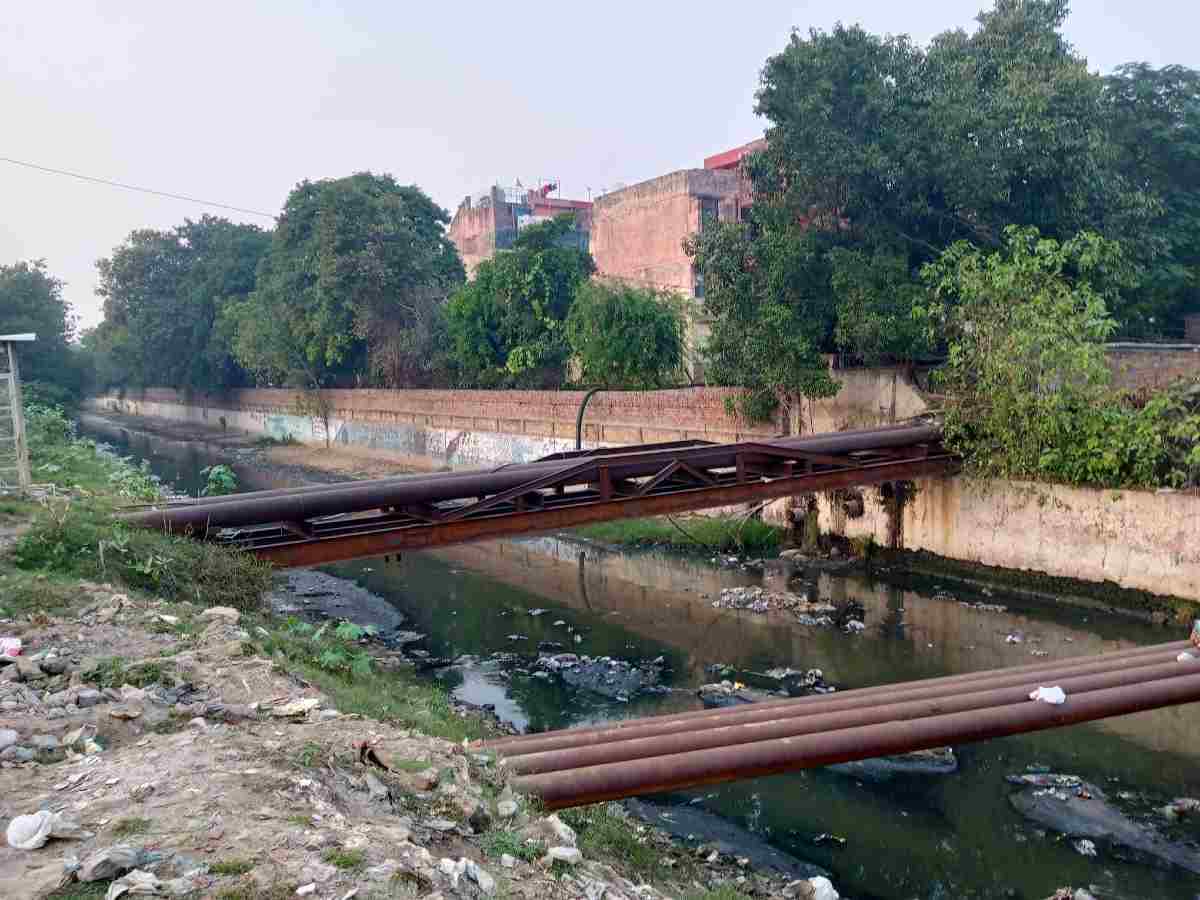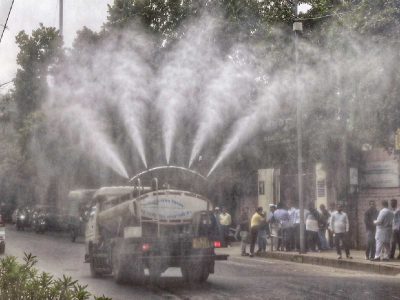As the monsoon is expected to arrive early this year, the national capital is once again at risk of severe waterlogging. Drainage maintenance agencies have fallen behind schedule in desilting operations, raising concerns about Delhi’s preparedness.
The Municipal Corporation of Delhi (MCD) reported on May 27 that 60% of desilting work had been completed on 800 deep drains—those over four feet deep. Although the deadline has been extended to June 15, zonal officers have been directed to reach at least 75% completion by June 5. Just four days earlier, on May 23, desilting progress stood at only 43%, highlighting the sluggish pace of work.
Special attention is being given to flood-prone locations such as Subhash Nagar, Pankha Road, Defence Colony, Hauz Khas near the metro station, Dariyai Nullah, Shadipur Depot, Taimoor Nagar in Maharani Bagh, Hatsal near Uttam Nagar, and MIG Flats in Rajouri Garden.
In Maharani Bagh, green patches and covered drains are being opened in phases for machine-based silt removal. At Defence Colony, slabs are being cut every 40 metres along a 1,100-metre stretch to access and clear the drains. Similar interventions are being carried out at Sunheri Pul, in compliance with National Green Tribunal (NGT) orders.
Drainage construction has been completed at Bada Bazar Road near Karol Bagh, where three people died due to flooding last year. Additional pumps have been installed along Pamposh Road to prevent recurrence.
PWD and I&FC miss desilting deadline
Desilting in Delhi is handled jointly by the MCD, Public Works Department (PWD), and Irrigation and Flood Control (I&FC) Department. The PWD is responsible for 2,064 kilometres of drains—roughly 55% of the city’s drainage infrastructure—while I&FC oversees major drains.
Despite their responsibilities, both PWD and I&FC missed the May 31 deadline.
As of May 29, I&FC data showed that desilting and disposal work on 77 key drains was only 62.8% complete. Out of the estimated 22.63 lakh metric tonnes of silt, only 14.22 lakh metric tonnes had been removed. The silt is being transported to MCD landfill sites in Bakkarwala, Rani Khera, and Jahangirpuri, and to low-lying areas such as Gopalpur and Tajpur Pahari.
To expedite operations, I&FC has deployed a fleet of recently procured machinery including draglines, backhoe loaders, amphibious and hydraulic excavators, dredgers, and weed harvesters.
Drainage system outdated, say officials
Officials from civic agencies acknowledge that persistent waterlogging despite desilting is the result of deeper structural issues. The existing drainage network, designed in 1976, was built to handle only 50 mm of rainfall per day.
“The system simply cannot bear the surging pressure,” said one official. “There is a desperate need for a new drainage master plan and the urgent application of new technologies to clean sections of the drain beneath culverts and roads constructed over 50 years ago.”
Location-specific interventions
The PWD is undertaking targeted interventions at chronically waterlogged locations.
A senior PWD official said, “At Minto Bridge, the department has constructed a new 1,000 mm drainage line to divert excess rainwater from Connaught Place Outer Circle, Ajmeri Gate, and Vivekanand Marg.”
In the ITO area, flooding is caused by water inflow from an MCD drain and low-lying stretches from Bahadur Shah Zafar Marg to Rajghat. To address this, the PWD is installing two additional drainage lines and deploying pumps.
Following recent rainfall, officials identified multiple waterlogging hotspots along Ring Road: IGI Stadium Gate No. 22, Mangi Bridge, Nigambodh Ghat, Majnu Ka Tila, Defence Colony Flyover, AIIMS Gate No. 2, Aradhana Bus Stand, Hyatt Residency, Panchsheel Flyover, and IIT Flyover.
“Most of these issues stem from blocked bell mouths clogged with garbage,” said officials. “Cleanup is underway, and additional pumps have been installed.”
Other locations also received attention. “At Tilak Bridge, two pits were dug on either side to allow complete desilting. At Pul Prahladpur underpass, the pump house is being automated and a 7.5 lakh-litre underground sump is under construction,” the official added. “Mobile and temporary pumps are also being prepared at multiple sites.”
IMD forecasts above-normal monsoon
The India Meteorological Department (IMD) has forecast an above-normal monsoon for Delhi this year. Although the exact date of arrival has not been announced, the rains are advancing ahead of schedule.
According to IMD Director General Mrutyunjay Mohapatra, the Delhi-Chandigarh-Haryana subdivision is expected to receive 114% of the Long Period Average (LPA) rainfall between June and September. The average for the region is 431 mm. Nationally, rainfall is expected to be 106% of the LPA.
Delhi has already received 186.4 mm of rainfall in May—its wettest May on record. Monsoon typically arrives around June 27.
Silt still lies on roadsides
Despite desilting efforts, large quantities of silt remain piled along roads instead of being transported to designated landfills.
The MCD had aimed to remove 1.29 lakh metric tonnes of silt from 800 deep drains across 530 kilometres by May 31 under Phase I of its monsoon readiness plan. However, by May 23, only 55,410 metric tonnes had been moved to landfill sites, with 4,000 to 5,000 metric tonnes still lying uncollected.
An MCD official said that though contractors were hired in February, the actual work was delayed. Contractors reportedly waited for large volumes to accumulate before transporting, leading to blockages and drain backflow during recent rains. Authorities have now instructed them to carry out smaller, more frequent removals.
Currently, silt is being dumped at Bhalswa and Ghazipur landfills; the Okhla landfill is not in use. In some areas, such as the Maharani Bagh drain, desilting may continue until June 20.
Drain cleaning in Delhi is divided into two phases. Phase I, from January to May, targets 60% desilting of deep drains and is often extended to mid-June. Phase II begins post-monsoon to maintain drainage flow. For 2025–26, the MCD has set a target of removing over 2.13 lakh metric tonnes of silt, including 84,466.6 metric tonnes in Phase II alone.
Experts stress structural reform
Experts attribute Delhi’s chronic waterlogging to a combination of outdated infrastructure, rapid urbanisation, and poor environmental planning.
Pushkar Pawar, a town planner with the MCD, said, “Stormwater drains are often clogged with silt, plastic, and construction debris. Over the years, natural drainage paths have been replaced with concrete structures, worsening the problem.”
“Most surfaces in Delhi are now covered in concrete or asphalt, which prevents rainwater from seeping into the ground. This leads to high surface runoff and overwhelms drains,” he added.
Pawar criticised the poor execution of desilting operations. “The removed silt is often left by roadsides and gets washed back into drains during early rains,” he said.
He recommends a data-driven approach. “Desilting should be based on measurements comparing current drain depths with original designs to assess silt levels,” he said. “The MCD’s efforts must begin by March and be supported by technology—such as GPS-enabled vehicles, photographic documentation, and real-time dashboards—to improve transparency.”
Pawar also called for better coordination among MCD, PWD, and I&FC through a central task force to avoid overlap and ensure citywide drainage coverage. He stressed the importance of emergency response teams in flood-prone areas and public awareness campaigns against drain dumping.
Looking to long-term solutions, Pawar advocated for integrating environmental planners into city governance. “These professionals evaluate drainage patterns, soil types, and rainfall trends to design eco-sensitive solutions like rain gardens, bioswales, and permeable pavements.”
“Such nature-based solutions help recharge groundwater, manage stormwater, and support biodiversity,” he said.
Also Read: Delhi: Clogged city drains leave the Capital flooded
Town planners also contribute to policy-making and land-use planning using tools such as GIS mapping and remote sensing to identify flood-prone areas. They serve as intermediaries between local authorities and residents, promoting participatory and sustainable urban practices.
Pawar concluded, “Delhi must shift from a reactive to a proactive model. Embedding environmental expertise at the grassroots level can reshape how we manage water and build climate resilience.”





